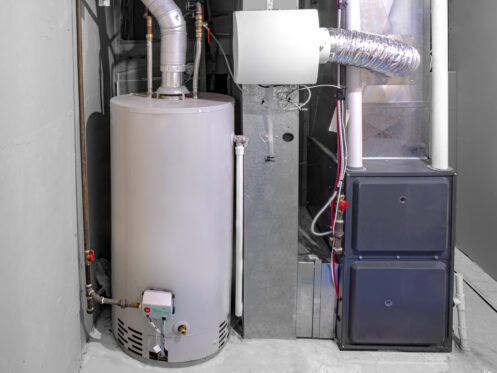Before the frigid temperatures arrive, you should consider upgrading to a high-efficiency gas furnace that will effectively heat your home and save you money. There are, however, many different models and features available on the market. To make sure you select the right one for your home, you should have a better idea of what you’re searching for. The most important aspect of selecting a high-efficiency gas furnace is finding one with a high AFUE rating.
Understanding AFUE Ratings
Furnaces are measured with an AFUE rating, which tells you how efficient the unit is at heating a space. You can use a unit’s AFUE rating to determine how much fuel needs to be used to heat your home. Higher AFUE ratings equate to more efficient systems and lower monthly utility bills. It’s possible for AFUE ratings to be measured at anywhere from 0-100%. When a system has a higher AFUE rating, this means that it will more effectively use combustion gases.
Difference Between SEER and AFUE
While you’re shopping for a new heating system, there are two ratings that you might come across, which include AFUE and SEER. The SEER rating is primarily used for air conditioners and certain HVAC systems, which includes the heat pump. The AFUE rating is mainly used to measure efficiency in a furnace. Both ratings are designed to compare energy input with heating or cooling output.
Ideal AFUE Rating
The ideal AFUE rating for the system you purchase depends on several factors. For example, homeowners in hotter climates don’t necessarily require the most efficient systems on the market. These units work best for people who live in colder climates and experience freezing temperatures consistently during the winter months.
At the moment, you can obtain furnaces with AFUE ratings at around 80%, which indicates that around eight-tenths of each BTU that’s used when running the furnace will reenter your home as heat. To understand which gas furnaces qualify as high-efficiency units, mid-efficiency systems come with AFUE ratings that can be anywhere from 90-93%. If you’re looking to buy a high-efficiency system, you should search for ones that offer AFUE ratings between 94-98.5%.
Benefits of Higher AFUE
There are several reasons why you should opt for a high-efficiency gas furnace that comes with a high AFUE rating, the primary of which is that you’ll be able to heat your home for less money. These savings should be immediately noticeable in the first few months after you install the new unit. Energy savings occur right away if your previous system wasn’t as efficient as your new one. While mid-range ratings may allow a unit to be more affordable, you’ll spend considerably more money heating your home throughout the year.
Focusing on Efficiency
The majority of furnaces run on gas, which is the most widely used heating fuel around. Now that you better understand how AFUE ratings work, you should have the information you need to find high-efficiency gas furnaces that will save you money and protect the environment. Efficient furnaces don’t produce as many emissions.
Over time, furnaces often become more efficient. For example, older gas furnaces that were built in the 1970s had AFUE ratings that were around 65%. Today, national law doesn’t allow companies to sell gas furnaces with an AFUE rating that’s lower than 80%. It’s possible for the latest models to have efficiency ratings that are just under 99%.
How Efficiency Effects Price
Furnace prices tend to increase when fuel efficiency gets higher. For example, a system that comes with an AFUE rating of 90% could cost anywhere from $500-$1,500 more when compared to a system that has a similar size but provides an 80% efficiency rating. The rate at which you recover some of your investments depends on where you live, your current gas rates, and the amount of insulation in your home.
When you’re weighing your options, make sure you compare models with different efficiencies to identify how much you’ll spend and save throughout the year. There are numerous online calculators that will tell you how much you’ll spend on gas prices once you input such information as:
- Electrical consumption
- Size of your home
- Unit’s AFUE rating
- Current utility rates
Additional Gas Furnace Features
Along with efficiency, there are several features and settings that you should be on the lookout for. Make sure you identify your budget before considering all your options.
Variable Settings
Many high-efficiency gas furnaces come with several variable settings, the primary of which include a variable heat output and variable-speed blowers. The variable heat output setting is available with systems that specifically offer a variable-speed blower.
This feature increases comfort levels and efficiency by altering the amount of heat the furnace emits based on the heating needs in your home. Variable-speed blowers don’t make as much noise and are capable of delivering air slower when you don’t need much heat.
Dual Heat Exchanger
Dual heat exchangers are components that are able to obtain heat from the gas that burns. Most energy-efficiency furnaces are equipped with a second exchanger that allows the system to draw in more heat from the surrounding air. Since it’s possible for the exhaust gases from the second exchanger to produce an acidic condensate, the component is often built with stainless steel and protected with plastic or a similar material.
Zoned Heating
Zoned heating is an appealing feature that uses numerous thermostats, dampers, and a central controller to precisely control airflow throughout your home. With this type of heating, your furnace can heat different rooms in your home to different temperatures. Zoned heating is particularly advantageous when implemented in larger homes.
Air Filtration
There are several air filtration options you’ll have access to when buying a gas furnace. For example, you can equip the furnace with an electrostatic filter that traps contaminants with an electrical charge. It’s also possible to install a HEPA filter in the system, which is effective at reducing the amount of contaminants in the air while also making sure dust doesn’t blow through your heating system. If you have allergies or asthma, air filtration is an important aspect of buying a high-efficiency gas furnace.
Total Gas Furnace Costs
Gas furnaces usually cost between $3,000-$12,000 depending on the difficulty of installation and the size of the furnace. While high-efficiency units tend to have higher upfront costs than ones with lower efficiency, you’ll benefit from more monthly energy savings that can offset the initial expenses.
When you’re calculating the continued operating costs, keep in mind that natural gas prices can differ from propane prices. In most cases, propane is more expensive than natural gas because of the delivery requirement. When you live in a warm environment, operating costs should be relatively low.
Once you’ve identified your preferred high-efficiency gas furnace, ask for assistance from our team at Bumble Breeze. We know how to install every type of furnace and can complete the process without creating a mess or damaging your home.
If you’re still looking for the best high-efficiency furnace, we can help you make an informed decision. Here at Bumble Breeze, we also offer HVAC repair and maintenance, plumbing, and indoor air quality services. Call Bumble Breeze to request our furnace installation services for your Las Vegas, NV home.


